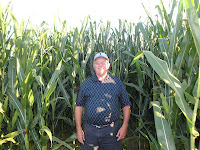
"I keep hearing that 2012 may be the largest corn acres year since 1946. I realize that was the year following WWII & the US govt wanted food production to get back up. But, I really question the acreage thing. 1946 was 2 yrs before I was born. But, in my recollection of the early '50s, it just doesn't seem possible that USA farmers could've had that many corn acres in 1946.
I realize we have lost acreage due to urban sprawl, but still, the acres in the '40s & early '50s were split between cash grain & animal production...at least in our part of the world, NE IL. Also, there are many parts of the USA that weren't capable of growing corn then ('40s) that may be now due to irrigation.
And, I think there were other crops such as cotton, vegetables & fruit crops that also impeded on the corn acres, but were necessary nonetheless. I wasn't a world traveler then or now, but I'm guessing much of the US had similar per farm acre balances. Soybeans weren't a big cash crop in Illinois in the late '40s yet, in fact I understand that we first grew them for hay in our area.
Still, there was a good percentage of ground growing oats back then. Oats for the food value for livestock & humans & the straw needed for bedding...again for livestock, and then oats was also the starter crop for the new hay needed. Then, another good portion of the farm was dedicated to the alfalfa, timothy or whatever hay crop. Then a smaller, though still significant portion of the farm was devoted to growing nothing at at all. It was known as "pasture". Again, for the animals.
With all those secondary crops, I doubt that left 1/2 the acreage for corn...here. So, was this just a Chebanse thing? Or did the rest of you grow corn fencerow to fencerow in '46? If so, how did you handle the harvest & where did you put the ear corn?
I'm skeptical of the numbers."
How about you? Are you skeptical of the reported USDA numbers Friday? I guess I am not. All of the above points make sense but since there were so few soybeans and no CRP in 1946, I am guessing the USDA has a pretty good estimate on acres of corn to be planted.
Ed




























